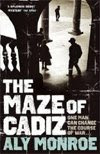
When I talked with Laura Wilson at the Electric Theatre in Guildford on October 22 we touched on the portrayal of history in film – mostly from the humble aspect of how people actually looked, moved and behaved in the 1940s and early 1950s.
I have fairly recently seen two films with a similar subject - a young woman agrees to ensnare an enemy official for what could be called a cause greater than her own physical and emotional well-being and even survival. The films are Black Book (2006) and Lust, Caution (2007). The first is set in Holland during WW2 and the second in Hong Kong and Shanghai during the Japanese occupation of China. Both end grimly, with multiple deaths.
Neither is a bad film, some of the performances are excellent. Tang Wei’s portrayal of her character in Ang Lee’s film is remarkable, nuanced and very brave.
But I want to concentrate on the look of the films. Let me put it this way - there are a lot of very good looking people, flawless teeth and a considerable expenditure and effort on stylish clothes and vehicles.
Now I have nothing against costume designers, art directors and careful lighting. But a stylish gleam does miss a lot that could inform the anguish and dilemmas the protagonists have to deal with. I don’t know how divine details are but they matter and I’d suggest, for this viewer anyway, that they are better rendered without too much prettification.
The Dutch film is not based on a book. Of course it is true that we all bring our own lives to reactions. One of my father’s closest friends was a Dutch mathematician. Aged seventeen when the Nazis invaded, his farmer parents were, of course, beside themselves with fear that he would be taken away to work camp or worse. The result was that he spent the ‘next two years dressed as girl or hiding in the woodpile.’ Of course it isn’t fair for me to ask the film makers to have this kind of very grim surrealism inform their work but I did find the sheer silk, well-cut trousers and slightly stressed new knitwear a distraction.
Lust, Caution is based on a short story by Eileen Chang. I kindled this up. Within a couple of pages there is the kind of passage that shows why words can outdo film images. It involves the hoarding of ‘Kerosene or pink diamonds’ – and reveals the world of collaborators’ wives in Shanghai as they play Mahjong. Kerosene was the highly inflammable fuel for lamps, heaters and, for the poor, cooking. It was dyed pink. It illustrates succinctly and precisely the unease of these women: they dread poverty and they need their wealth to be easily transportable and to keep its value.
Ang Lee is very respectful of his source. It may just be I am getting old. But movies simply don’t allow the same kind of appreciation of the world behind such a remark. Not of course when you are watching beautiful people exquisitely dressed and lit.
Still photographs work however. In the last day or so I have been looking at photographs published in some British newspapers. They come from an exhibition called “The Radical Camera: New York’s Photo League 1936 – 1951” at The Jewish Museum in New York from November 04 2011 – March 25 2012.
I have ‘borrowed’ one for this blog. It shows a film poster of a book I mention in the next Peter Cotton and has that wonderful boy and tyre. Yes, it’s a frame but it has all kinds of possibilities and stories.
My father’s tall Dutch friend grew his hair and wore a dress and hid in the woodpile, looking at the mathematical possibilities in curled woodlice. The last time I saw him he asked me what the British had against mixer taps or faucets. A little later he said his main memory of his time in the woodpile was smell. ‘I stank’ he said.
Perhaps that’s the problem. Films can stink but they can’t invoke smell. I don’t know the smell of kerosene but my husband remembers it well from his childhood in Africa.







No comments:
Post a Comment